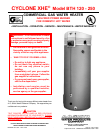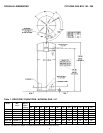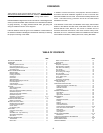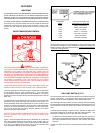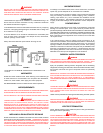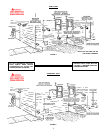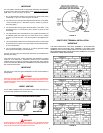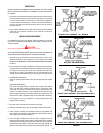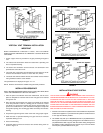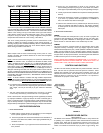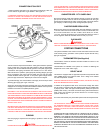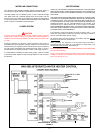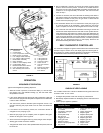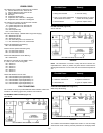
5
DISHWASHING MACHINE REQUIREMENT
All dishwashing machines meeting the National Sanitation Foundation
requirements are designed to operate with water flow pressures between
15 and 25 pounds per square inch. Flow pressures above 25 pounds per
square inch, or below 15 pounds per square inch, will result in improperly
sanitized dishes. Where pressures are high, a water pressure reducing
or flow regulating control valve should be used in the 180°F line to the
dishwashing machine, and should be adjusted to deliver water between
these limits.
The National Sanitation Foundation also recommends circulation of 180°F
water. Where this is done, the circulation should be very gentle so that it
does not cause any unnecessary turbulence inside the water heater. The
circulation should be just enough to provide 180°F water at the point of
take-off to the dishwashing machine. Adjust flow by means of the plug
cock in the circulating line. (See installation diagrams.)
CIRCULATING PUMP
A circulating pump is used when a system requires a circulating loop or
there is a storage tank used in conjunction with the heater. Refer to the
piping diagrams at rear of manual for electrical hookup information and
install in accordance with the latest version of the National Electric Code
ANSI/NFPA No. 70.
Only all bronze circulators are used with commercial water heaters.
Although circulators are oiled and operated by the manufacturer some
circulators must be oiled again before operated. Please refer to
manufacturer's instructions.
INSTALLATION INSTRUCTIONS
REQUIRED ABILITY
INSTALLATION OR SERVICE OF THIS WATER HEATER REQUIRES ABILITY
EQUIVALENT TO THAT OF A LICENSED TRADESMAN IN THE FIELD
INVOLVED. PLUMBING, AIR SUPPLY, VENTING, GAS SUPPLY AND
ELECTRICAL WORK ARE REQUIRED.
INSULATION BLANKETS
Insulation blankets available to the general public for external use on gas
water heaters are not approved for use on your A.O. Smith water heater.
The purpose of an insulation blanket is to reduce the standby heat loss
encountered with storage tank water heaters. Your A.O. Smith water
heater meets or exceeds the ASHRAE/IES 90.1b 1992 standards with
respect to insulation and standby loss requirements, making an insulation
blanket unnecessary.
WARNING
Should you choose to apply an insulation blanket to this heater, you should
follow these instructions. Failure to follow these instructions can result in
fire, asphyxiation, serious personal injury or death.
Do not apply insulation to the top, or the upper 15" of the water heater,
as this will interfere with safe operation.
Do not cover the temperature & pressure relief valve.
Do not cover the instruction manual. Keep it on the side of the water
heater or nearby for future reference.
Do obtain new labels from A.O. Smith for placement on the blanket
directly over the existing labels.
LOCATING THE HEATER
WARNING
THERE IS A RISK IN USING FUEL BURNING APPLIANCES SUCH AS GAS
WATER HEATERS IN ROOMS, GARAGES OR OTHER AREAS WHERE
GASOLINE, OTHER FLAMMABLE LIQUIDS OR ENGINE DRIVEN EQUIPMENT
OR VEHICLES ARE STORED, OPERATED OR REPAIRED. FLAMMABLE
VAPORS ARE HEAVY AND TRAVEL ALONG THE FLOOR AND MAY BE
IGNITED BY THE HEATERS IGNITER OR MAIN BURNER FLAMES CAUSING
FIRE OR EXPLOSION. SOME LOCAL CODES PERMIT OPERATION OF GAS
APPLIANCES IF INSTALLED 18 INCHES OR MORE ABOVE THE FLOOR.
THIS MAY REDUCE THE RISK IF LOCATION IN SUCH AN AREA CANNOT BE
AVOIDED.
THE HEATER SHALL BE LOCATED OR PROTECTED SO IT IS NOT SUBJECT
TO PHYSICAL DAMAGE BY A MOVING VEHICLE.
DO NOT LOCATE THE HEATER WHERE NOISE FROM THE EXHAUST OR
INTAKE WILL BE OBJECTIONABLE. THIS INCLUDES LOCATIONS CLOSE TO
OR ACROSS FROM WINDOWS AND DOORS. AVOID ANCHORING THE
VENT AND INTAKE PIPES DIRECTLY TO FRAMED WALLS, FLOORS OF
CEILINGS UNLESS RUBBER ISOLATION PIPE HANGERS ARE USED. THIS
PREVENTS ANY VIBRATIONS FROM BEING TRANSMITTED INTO THE LIVING
SPACES.
WARNING
FLAMMABLE ITEMS, PRESSURIZED CONTAINERS OR ANY OTHER
POTENTIAL FIRE HAZARDOUS ARTICLES MUST NEVER BE PLACED ON
OR ADJACENT TO THE HEATER. OPEN CONTAINERS OF FLAMMABLE
MATERIAL SHOULD NOT BE STORED OR USED IN THE SAME ROOM WITH
THE HEATER.
When installing the heater, consideration must be given to proper location.
Location selected should be as close to the intake and exhaust termination
points as practicable, with adequate air supply and as centralized with the
piping system as possible.
THE HEATER MUST NOT BE LOCATED IN AN AREA WHERE IT WILL BE
SUBJECT TO FREEZING.
LOCATE IT NEAR A FLOOR DRAIN. THE HEATER SHOULD BE LOCATED IN
AN AREA WHERE LEAKAGE FROM THE HEATER OR CONNECTIONS WILL
NOT RESULT IN DAMAGE TO THE ADJACENT AREA OR TO LOWER FLOORS
OF THE STRUCTURE.
When such locations cannot be avoided, it is recommended that a suitable
drain pan, adequately drained, be installed under the appliance.
WARNING
THIS WATER HEATER IS A CONDENSING UNIT AND REQUIRES A DRAIN TO
BE LOCATED IN CLOSE PROXIMITY TO ALLOW THE CONDENSATE TO
DRAIN SAFELY. THE CONDENSATE DRAINS FROM THE UNIT AT THE
EXHAUST ELBOW LOCATED AT THE BOTTOM OF THE UNIT. NOTE: IT IS
IMPORTANT THAT THE CONDENSATE HOSE NOT BE ELEVATED ABOVE
THE EXHAUST ELBOW (SEE FIGURE 3). THE CONDENSATE BUILD-UP WILL
BLOCK THE EXHAUST OUTLET, WHICH WILL CAUSE IMPROPER
OPERATION.
FIGURE 3



